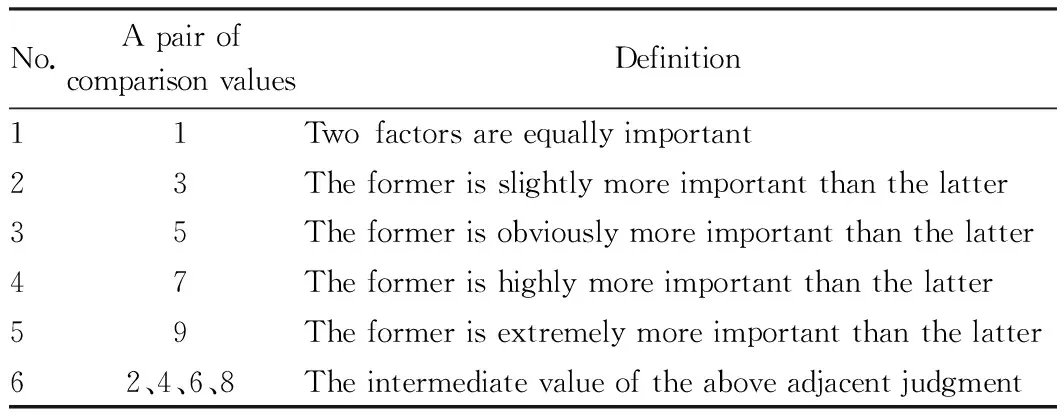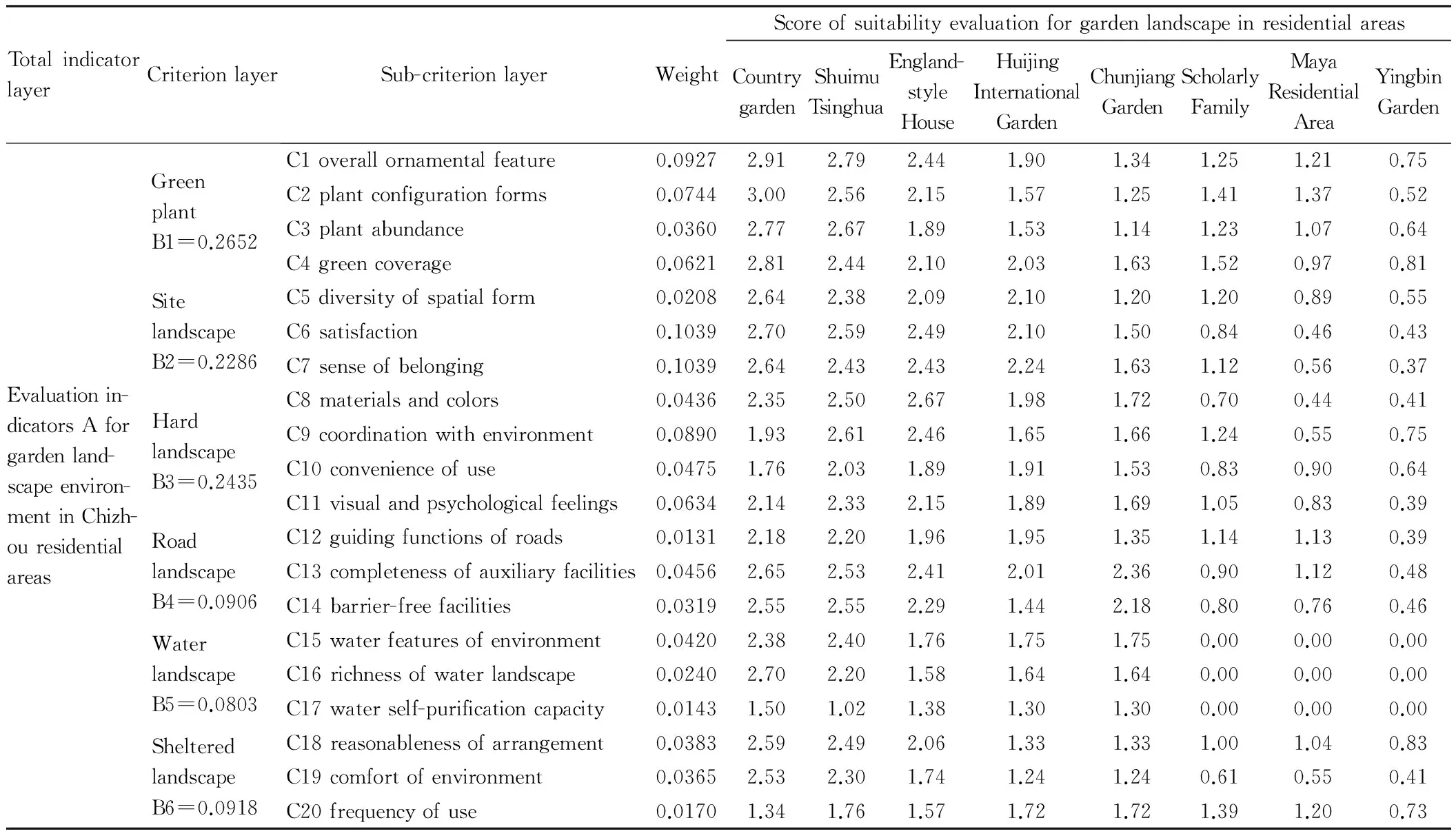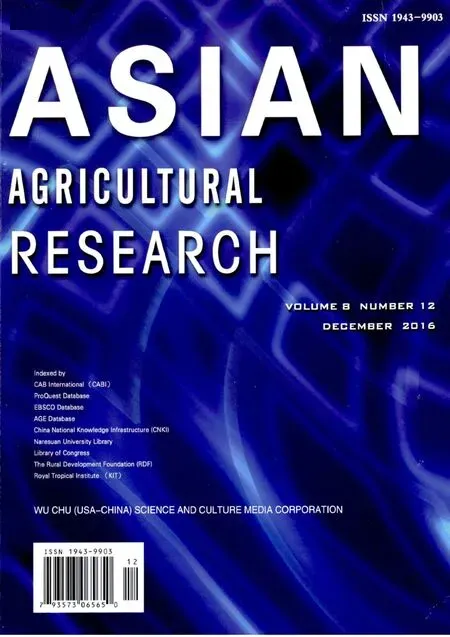Suitability Evaluation of Garden Landscape in Chizhou Residential Area
School of Economics and Management, Zhejiang Ocean University, Zhoushan 316022, China
1 Introduction
With all-round extension of new urbanization and urban and rural integration and demands for open blocks, urban physical environment elements, such as rivers, lakes, forests and grasslands, air and soil, have been damaged in varying degrees, and seriously threaten healthy and sustainable development of living environment. In the construction of urban garden green space system, the landscape quality of garden plants will determine the overall level of urban green space system[1]. Improve the living environment and creating comfortable and pleasant living space have become an important common understanding of human self-improvement and self-development process. Urban residential area, as relatively independent and open public space, is an important habitat for activities of residents. In recent years, theoretical researches about residential landscape have gradually become mature:GardenDesign:UrbanLandscapeby Meng Zhaozhen[2],ProblemsofGardenLandscapeinNanningResidentialAreaby Liangli[3],GardenLandscapeEvaluationandOptimizationofNanjingResidentialAreaby Zheng Xiaojuan[4],TheReflectionofCurrentLandscapeDesignofResidentialCommunityinCitiesby Zhang Wenying[5]. Through in-depth research and analysis, these scholars applied their own specific research methods, obtained relatively applicable models objectively reflecting the landscape characteristics of urban residential areas, and have made considerable research findings. However, three are few researches about suitability evaluation of garden landscape in residential areas by analytic hierarchy process (AHP)[6], and no research about overall living environment of Chizhou as research object.
2 Study methods
Chizhou City is a core area of international cultural tourism demonstration zone of southern Anhui Province, the first domestic "Eco-economic Demonstration Zone" and "Waterfront Leisure Ecotourism City", and the first "sponge city" construction pilot city[7], and its ecological quality has attracted a wide attention of the society and residents. Firstly, we established a reasonable and feasible landscape evaluation system, introduced the AHP, and transformed subjective judgments into objective description through the quantitative processing. We made weight assignment judgment according to the importance of all levels of garden landscape elements and decision-making level. Through the judgment matrix, we can get the weight value of the garden elements in the urban garden system, and use it as the basis for decision-making of landscape construction[8]. Secondly, we mainly used the typical green space sampling survey method to analyze the public green space, road greenbelt and house green space in the residential areas, and selected typical quadrat to carry out consolidation and statistics of the diversity of tree species. Thirdly, we carried out analysis and evaluation of garden landscape of different residential areas based on the modern, the core is to transform the qualitative indicators into quantitative indicators, so as to provide decision-making basis for decision-makers. We analyzed merits and drawbacks of garden landscape elements of different regions, built judgment matrix and calculated the weight value of the judgment matrix by square root method, and carried out the consistency test[9], to test the feasibility of the model.
3 Building model for suitability evaluation of garden landscape in residential areas
3.1SelectionofevaluationfactorsIn order to guarantee the evaluation model is generally applicable, taking theDirectiveCodeofResidentialAreasEnvironment&LandscapeDesign(2006 formal version) as the basis, combined with landscape aesthetics, landscape design principles, landscape ecology principles, and characteristics of Chizhou City, following basic requirements of landscape design, we selected evaluation factor indicator system. Selection of the criterion layer indicators[10]is as follows. (i) Ornamental feature of the overall environment: it is divided into excellent, good, general, and poor according to intuitive feelings. (ii) Plant configuration types[11]: it can be divided into very complex, complex, general, and simple according to the complexity of plant configuration. (iii) The green coverage of the garden landscape: taking the Directive Code as basic basis, it can be divided into excellent (>35%), good (35%-30%), general (30%-25%), and poor (<20%). (iv) Plant species abundance: it can be divided into extremely high (> 50%), relatively high (30% -50%), general (10%-29%), and low (< 10%) according to the proportion of the total number of species in the same region or in the same administrative division. (v) The diversity of spatial form[12]: it can be divided into very complex (<40%), complex (40%-60%), general (60%-70%), and simple (> 70%) according to the complexity of spatial form. (vi) The satisfaction of overall environment[13]: it can be divided into well satisfied, satisfied, less satisfied, and unsatisfied according to the intuitive experience of users. (vii) The sense of belonging: it can be divided into very strong, strong, general, and weak according to the living experience of users. (viii) Hard landscape materials and colors[14]: it can be divided into excellent, good, general, and poor according to elements of selected hard landscape materials and colors. (ix) The degree of coordination between hard landscape elements and habitat: it can be divided into well coordinated, coordinated, not coordinated, and poor according to the degree of coordination between the hard landscape elements and the surrounding environment. (x) The practical level of hard landscape elements: it can be divided into extremely practical, practical, not applicable, and poor according to the practical level of the hard landscape elements in daily life. (xi) Visual and psychological feelings of the hard landscape elements: it can be divided into very strong, strong, general, and weak according to the visual and psychological feelings of the hard landscape elements. (xii) Guiding functions of roads: it can be divided into very strong, strong, general and weak according to level of guiding functions of roads. (xiii) The completeness of auxiliary facilities: it can be divided into excellent, good, general and poor according to the completeness of auxiliary facilities in residential areas. (xiv) The reasonableness of barrier-free design: it can be divided into very reasonable, reasonable, unreasonable, and poor according to convenience degree of barrier-free travel. (xv) Water features of landscape: it can be divided into excellent, good, general, and poor according to the water demands of users and water landscape elements of the fitting degree. (xvi) The richness of water landscape types: it can be divided into very complex (<40%), complex (40%-50%), simple (50%-60%), and poor (> 60%) according to the complexity of water landscape types. (xvii) Water self-purification capacity: it can be divided into very strong, strong, general, and weak according to self renewal and purification ability of water in natural state. (xviii) The reasonableness of arrangement of the sheltered landscape: it can be divided into highly reasonable, reasonable, general, and unreasonable according to the actual demands of users and the degree of reasonableness of arrangement of the landscape elements. (xix) The comfort of sheltered landscape: it can be divided into excellent, good, general, and poor according to the comfort of sheltered landscape. (xx) The frequency of the use of sheltered landscape:it can be divided into very frequent (> 25 times), frequent (15-25 times), general (10-15 times), and seldom (<10 times) according to average monthly use times of each user. We divided the indicator factors of criterion layer into three levels with the scores of 0-1, 1-2, and 2-3, respectively, and the evaluation layer corresponds to unsuitable, general and suitable. We divided the sub-criterion layer into four and assigned 0 point, 1 points, 2 points, and 3 points separately. When assigning values to the landscape elements, if the actual situation remains between the two levels, it is necessary to conduct the second assignment according to the actual situation.

Data source: automatically generated from evaluation model.
Fig.1SuitabilityevaluationmodelforgardenlandscapeinChizhouresidentialarea
3.2EstablishmentofevaluationmodelThrough the literature reference and expert consultation, with the aid of yaahp software, and according to the operation steps of the environment evaluation model for garden landscape in Chizhou residential areas (as shown in Fig. 1), we compared the evaluation indicators at each level and made the assignment judgment.
According to the judgment matrix A, it is also provided with following feature:aij> 0,aij=1/aji, whereaij(i,j= 1, 2K,Kn) weight value denotes the proportion of importance of evaluation indicatorAitoAj. We divided the relative importance of the adjacent layer, and denote using the natural number 1-9 and respective reciprocal. The standard group for value setting and the corresponding meaning are shown in Table 1.
A=(aij)n×n
(1)
Table1Standardgroupforvaluesetting

No.ApairofcomparisonvaluesDefinition11Twofactorsareequallyimportant23Theformerisslightlymoreimportantthanthelatter35Theformerisobviouslymoreimportantthanthelatter47Theformerishighlymoreimportantthanthelatter59Theformerisextremelymoreimportantthanthelatter62、4、6、8Theintermediatevalueoftheaboveadjacentjudgment
Data source: self prepared.
Set the maximum eigenvector root of the judgment matrixAtoλmax, the corresponding eigenvector isW. As per the formulaAW=λmaxW, eigenvectorWis normalized into the weight vector of the relative importance of a factor at the same level of the corresponding elements compared to the previous level. According to the formulas (2), (3), and (4), we carried out the consistency test of the matrix.
(2)

(3)

(4)
wherenis the dimension of judgment matrix, andλmaxis the maximum eigenvalue of judgment matrix. IfCI= 0, the result of judgment matrixAis exactly the same as the actual situation; if theCIvalue is larger, the consistency of judgment matrix with actual situation will be worse. The difference in subjective cognition may lead to the existence of random error. Therefore, a random correction coefficient RI should be introduced to avoid the influence of random error when carrying out the consistency test. Relative consistency indicatorCR,CR=CI/RI. IfCR< 0.10, the judgment matrix is deemed to have consistency. Through calculation, we obtained the value of RI, as listed in Table 2, and the judgment matrix meets the requirements and has the consistency.
Table2Randomconsistencyindicatorofthejudgmentmatrixatdifferentstages

EvaluationfactorRIEvaluationfactorRIRoadlandscape0.027Hardlandscape0.015Greenplantlandscape0.015Waterlandscape0Sitelandscape0Shelteredlandscape0.027
Data source: self prepared.
4 Evaluation and analysis on suitability of garden landscape in sample residential areas
4.1SurveyofgardenlandscapeinsampleresidentialareasWe firstly surveyed 8 residential areas in Chizhou City: Maya residential area, Shuimu Tsinghua, Yingbin Garden, Country Garden, Chunjiang Garden, Huijing International Garden, England-style House, Scholarly Family; we studied and analyzed landscape closely related to daily life of residents: house green space, public green space, and road green space. For different residential areas, we selected the main elements of garden landscape in sample residential areas (namely, the sub-criterion layer evaluation factors), and carried out photo taking and statistics of the relevant indicators. We invited 20 landscape experts and designers to assign and evaluate 30 photos of current situation of the landscaping plants in eight residential areas.
4.2Evaluationandanalysisongardenlandscapeinsampleresidentialareas
4.2.1Evaluation of garden landscape in sample residential areas. In the elements of garden landscape evaluation system, we took factors with weight value higher than 0.06 as the strong influencing factors, factors with weight value between 0.02-0.06 as the intermediate influencing factors, and factors with weight value lower than 0.02 as the weak influencing factor. From Table 3, three items of the criterion layer (green plant landscape, hard landscape, and site landscape) account for 73.73% of total indicator layer, and are leading evaluation factors for suitability evaluation of garden landscape in residential areas.
According to the strength, the influencing factors can be divided into (i) strong influencing factors: ornamental feature of the overall environment, green coverage of the garden landscape, plant configuration types, the sense of belonging, the satisfaction of overall environment, visual and psychological feelings of the hard landscape elements, and the degree of coordination between hard landscape elements and habitat. These 7 factors account for 58.94% of total indicators. (ii) Intermediate influencing factors: plant species abundance, diversity of spatial form, hard landscape materials and colors, convenience of use, completeness of auxiliary facilities, reasonableness of barrier-free facilities, richness of water landscape types, water features of landscape, reasonable of arrangement of the sheltered landscape, and comfort of sheltered landscape. These 10 factors account for 36.62% of total indicators. (iii) Weak influencing factors: water self-purification capacity, guiding functions of roads, and frequency of the use of sheltered landscape. These 3 factors account for 4.44% of total indicators.
Table3SuitabilityevaluationsystemforgardenlandscapeinChizhouresidentialareas

TotalindicatorlayerCriterionlayerSub-criterionlayerWeightScoreofsuitabilityevaluationforgardenlandscapeinresidentialareasCountrygardenShuimuTsinghuaEngland-styleHouseHuijingInternationalGardenChunjiangGardenScholarlyFamilyMayaResidentialAreaYingbinGardenEvaluationin-dicatorsAforgardenland-scapeenviron-mentinChizh-ouresidentialareasGreenplantB1=0.2652SitelandscapeB2=0.2286HardlandscapeB3=0.2435RoadlandscapeB4=0.0906WaterlandscapeB5=0.0803ShelteredlandscapeB6=0.0918C1overallornamentalfeature0.09272.912.792.441.901.341.251.210.75C2plantconfigurationforms0.07443.002.562.151.571.251.411.370.52C3plantabundance0.03602.772.671.891.531.141.231.070.64C4greencoverage0.06212.812.442.102.031.631.520.970.81C5diversityofspatialform0.02082.642.382.092.101.201.200.890.55C6satisfaction0.10392.702.592.492.101.500.840.460.43C7senseofbelonging0.10392.642.432.432.241.631.120.560.37C8materialsandcolors0.04362.352.502.671.981.720.700.440.41C9coordinationwithenvironment0.08901.932.612.461.651.661.240.550.75C10convenienceofuse0.04751.762.031.891.911.530.830.900.64C11visualandpsychologicalfeelings0.06342.142.332.151.891.691.050.830.39C12guidingfunctionsofroads0.01312.182.201.961.951.351.141.130.39C13completenessofauxiliaryfacilities0.04562.652.532.412.012.360.901.120.48C14barrier-freefacilities0.03192.552.552.291.442.180.800.760.46C15waterfeaturesofenvironment0.04202.382.401.761.751.750.000.000.00C16richnessofwaterlandscape0.02402.702.201.581.641.640.000.000.00C17waterself-purificationcapacity0.01431.501.021.381.301.300.000.000.00C18reasonablenessofarrangement0.03832.592.492.061.331.331.001.040.83C19comfortofenvironment0.03652.532.301.741.241.240.610.550.41C20frequencyofuse0.01701.341.761.571.721.721.391.200.73
Data source: arranged on the basis of model analysis results.

Data source: self prepared.
Fig.2Distributionofsub-criterionlayerevaluationfactorweightinthegardenlandscapeevaluationsystemforChizhouresidentialareas
4.2.2Analysis of garden landscape in sample residential areas. According to the analysis of the evaluation model, there are great differences between different regions. The overall quality of garden landscape in residential areas of Downtown, Zhanqian District, and Qishan Mountain and Pingtian Lake Resort District takes up the major position in evaluation system, and garden landscape has higher quality; in Downtown, Eastern Economic Park, Maya Tourist Service Area, the garden landscape is relatively weak in evaluation system, and garden landscape quality is low and it lacks humane caring of landscape[15]. In the garden landscape suitability evaluation model, there are great differences in indicator factors of the criterion layer. Through assignment calculation of the judgment matrix, we obtained the average score of 7 strong influencing factors: 1.67 points; the average score of 10 intermediate influencing factors: 1.48 points; the average score of 3 weak influencing factors is 1.25 points. In the evaluation indicator system, there are also great differences in 20 items of sub-criterion layer evaluation factors, as shown in Fig. 2. The ornamental feature of the overall environment, green coverage of the garden landscape, plant configuration types, the sense of belonging, the satisfaction of overall environment, visual and psychological feelings of the hard landscape elements, and the degree of coordination between hard landscape elements and habitat have strong influence on the evaluation indicator system; the plant species abundance, diversity of spatial form, hard landscape materials and colors, convenience of use, completeness of auxiliary facilities, reasonableness of barrier-free facilities, richness of water landscape types, water features of landscape, reasonable of arrangement of the sheltered landscape, and comfort of sheltered landscape have intermediate influence on the evaluation indicator system; the water self-purification capacity, guiding functions of roads, and frequency of the use of sheltered landscape basically have no influence on the evaluation indicator system.
5 Conclusions and discussions
Through the field survey of construction of garden landscape in residential areas, combined with the analytic hierarchy process (AHP), we established a reasonable and feasible suitability evaluation system for garden landscape in residential areas. Our analysis indicated that the environment of garden landscape in residential areas of Chizhou City in Anhui province remains at the level of intermediate and lower level, and there are great differences between different areas, showing high unbalance. In water self-purification capacity, guiding functions of roads, and frequency of the use of sheltered landscape, the effect is poorest. In later period of construction, it is required to take overall consideration of the relationship between people, logistics, and traffic information flow in the residential areas, properly treat the relationship between practicality and accessibility of roads; when arranging water landscape, it is required to keep flow of water body and strengthen water self-purification capacity; when arranging sheltered landscape, it is required to consider the travel psychology, behavior custom, visual effect, and experience effect of residents, so as to better serve people. For those areas with living as main function, residential area planning and construction should center on demands of residents. The landscape design full of humane care must properly treat the relationship between elements of garden landscape and the sharing of resources. In later period of construction, we should strengthen input in the soft material environment in the residential area, provide appropriate infrastructure suitable for the size of residential area, and accelerate the transformation of many unreasonable problems in residential areas, to better serve the majority of residential areas. In addition, we should cultivate the sense of pride and sense of responsibility of the main residents of residential areas. Through organizing some training and lecture activities, it is expected to make owners fully participate in the greening projects of the residential landscape and other activities, and enhance the subject awareness of residents, and to join in teams of protecting environment and creating beautiful life.
[1] LU S. A study on sustainable landscape design of residential area[D]. Beijing:Beijing Forestry University, 2010. (in Chinese).
[2] MENG ZZ. Landscape design for urban landscape[J]. Chinese Landscape Architecture, 2002(4):13-16. (in Chinese).
[3] LIANG L. Disssion on the problems in landscape architecture of Nanning residential area[J]. Journal of Guangxi University(Philosophy and Social Science), 2009, 31(9): 111-112. (in Chinese).
[4] ZHENG XJ. Research on evaluating and optimizing of Nanjing urban residential sub-districts landscape[D]. Nanjing: Nanjing Forestry University, 2008. (in Chinese).
[5] ZHANG WY. The reflection of current landscape design of residential community in cities[J]. Chinese Landscape Architecture, 2005(1):62-66. (in Chinese).
[6] QIN J, ZHANG JP. Application of cortemporary statistical information analysis method in safety engineering——The principle of AHP[J]. Industrial Safety and Dust Control, 1999, 25(5):44-48. (in Chinese).
[7] DONG SQ, HAN ZG. Study on planning an "eco-sponge city" for rainwater utilization[J]. Urban Studies, 2012, 18(12) : 37-41. (in Chinese).
[8] LIU X. The application of analytic hierarchy process in the old urban area reconstruction planning[J]. Urban Planning Forum, 1991(1): 53-56. (in Chinese).
[9] LI KL. Using analytic hierarchy process in urban road landscape evaluation[J]. Engineering Journal of Wuhan University, 2005, 38(1): 143-147, 152. (in Chinese).
[10] CHEN B, BAO ZY. Ecological planning: Development, modes, lodestar and goal[J]. Chinese Landscape Architecture, 2003(1): 48-51. (in Chinese).
[11] SU XH. Plant landscape[M]. Beijing: China Forestry Publishing House, 1994. (in Chinese).
[12] LIU BY. Modern planning and design of landscape[M]. Nanjing: Southeast University Press, 1999. (in Chinese).
[13] ZHANG S. Study on the evaluation index system of ecological benefits of green ecological residence community in Chengdu City[D] . Chengdu: Sichuan Agricultural University, 2006. (in Chinese).
[14] FU GR. City characteristics and color control[J]. Planners, 2003, 19(1): 39-42. (in Chinese).
[15] WU LY. Introduction to sciences of human settlement[M]. Beijing: China Building Industry Press, 2001. (in Chinese).
 Asian Agricultural Research2016年12期
Asian Agricultural Research2016年12期
- Asian Agricultural Research的其它文章
- How to Improve Tea Farmers’ Livelihoods in the Sightseeing Place along Lijiang River Valley?
- Brand Construction of Agricultural Enterprises: A Case Study of Hubei Hanway Ecological Agriculture Group
- Impact of Online Comments on Purchase Intention of College Student Consumers under Online Shopping
- Empirical Research on Farmer’s Breaching Behavior in Order Contract
- Effect of Vector Density and Competence on Macromolecular Vector Transformation Efficiency
- Evaluation on the Level of Agricultural Informatization Development in Gansu Province during 2001-2010
